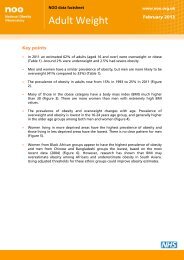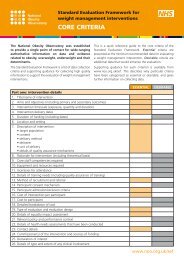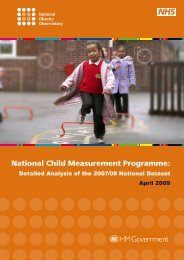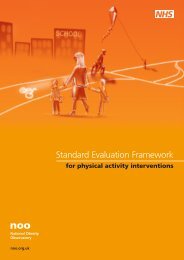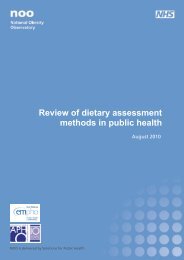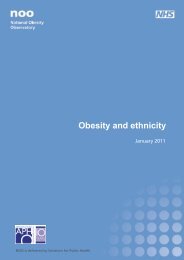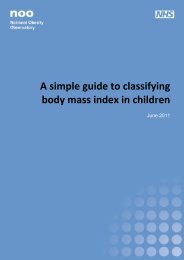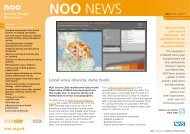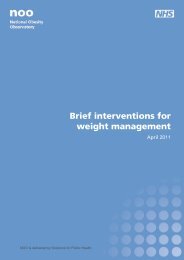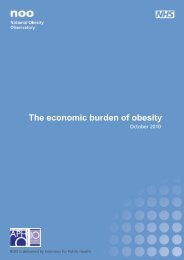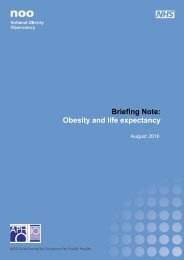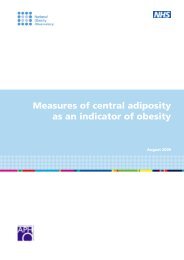Knowledge and attitudes towards healthy eating and physical activity:
Knowledge and attitudes towards healthy eating and physical activity:
Knowledge and attitudes towards healthy eating and physical activity:
You also want an ePaper? Increase the reach of your titles
YUMPU automatically turns print PDFs into web optimized ePapers that Google loves.
to the recommended levels of <strong>activity</strong> when the HSE 2007 survey was undertaken). A<br />
further 24% of adults specified that a higher level of <strong>physical</strong> <strong>activity</strong> than this should<br />
be undertaken.<br />
ii. Perceptions of <strong>physical</strong> <strong>activity</strong> facilities<br />
The Active People Survey 2008 (APS 2008) asked how satisfied participants were with<br />
sports facilities in their local area. Almost 60% said they were ‘fairly’ or ‘very satisfied’,<br />
whilst fewer than 15% felt ‘fairly’ or ‘very dissatisfied’. Figure 8 shows the range of<br />
responses.<br />
Figure 8: Responses of adults to the question ‘How satisfied are you with sports<br />
provision in your local area’<br />
45%<br />
40%<br />
35%<br />
30%<br />
25%<br />
20%<br />
15%<br />
10%<br />
5%<br />
0%<br />
Very<br />
dissatisfied<br />
Fairly<br />
dissatisfied<br />
Neither satisfied or<br />
dissatisfied<br />
Fairly<br />
satisfied<br />
Very<br />
satisfied<br />
No opinion/not<br />
stated<br />
Source: APS, 2008<br />
The Place Survey provides some information about access to sports facilities, parks <strong>and</strong><br />
open spaces. The data shows that the majority of respondents had used such facilities<br />
in the previous six months or year, with more respondents using parks <strong>and</strong> open<br />
spaces than sports facilities (see Appendix 3, Table 6). There is no data available about<br />
frequency of use.<br />
iii. Appraisal of own participation in <strong>physical</strong> <strong>activity</strong><br />
The HSE 2007 asked participants how <strong>physical</strong>ly active they considered themselves to<br />
be compared to others of their own age. a Whilst the majority of adults (71%)<br />
considered themselves to be ‘fairly’ or ‘very’ <strong>physical</strong>ly active, the results varied<br />
according to gender <strong>and</strong> BMI. Respondents who were obese or morbidly obese were<br />
significantly more likely than those of a <strong>healthy</strong> weight to say they were either ‘not<br />
very’ or ‘not at all’ <strong>physical</strong>ly active (see Appendix 3, Table 7). Participants were also<br />
a<br />
‘Physical <strong>activity</strong>’ was defined as: ‘A wide range of activities involving movement including housework such as<br />
vacuuming <strong>and</strong> digging the garden, active hobbies, walking <strong>and</strong> cycling, dancing, exercise such as swimming or going to<br />
the gym, <strong>and</strong> sport. It includes movement done as part of a job such as walking, lifting <strong>and</strong> carrying’.<br />
NOO | <strong>Knowledge</strong> <strong>and</strong> <strong>attitudes</strong> <strong>towards</strong> <strong>healthy</strong> <strong>eating</strong> <strong>and</strong> <strong>physical</strong> <strong>activity</strong>: what the data tell us 17



